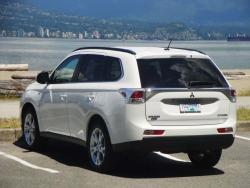 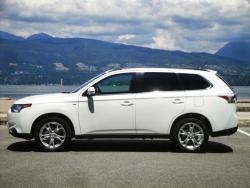 2014 Mitsubishi Outlander GT S-AWC Navi. Click image to enlarge |
Review and photos by Greg Wilson
Perhaps Mitsubishi didn’t get the memo: V6s are out; turbo fours are in.
Other manufacturers of compact SUVs have been rushing to replace their optional V6 engines with more economical turbocharged fours (Escape, Sportage, Santa Fe), or even abandon their sixes altogether (Tucson, RAV4) – but Mitsubishi has decided to keep their optional 3.0L V6 (with minor changes) in the redesigned 2014 Outlander. A revised 166-hp 2.4L single overhead cam four is still the standard engine in the base Outlander ES 2WD and ES AWC trims but the 227-hp 3.0L V6 remains standard in the SE AWC and GT S-AWC trims. It wouldn’t be difficult for Mitsubishi to replace their V6 with the 237-hp 2.0L turbo four found in the Lancer Ralliart, so why don’t they?
There are a few good reasons, actually. Currently, 70 percent of Outlander buyers choose the V6 engine over the base four-cylinder. The 3.0L six is quiet, smooth and powerful, and combined with the standard six-speed automatic transmission, delivers a more linear power progression than the Outlander’s standard four-cylinder/CVT combination. Autos.ca contributor Lesley Wimbush had similar impressions in her First Drive of the 2014 Outlander in March. Minor changes to the V6 this year include new high ignition spark plugs, moving parts with reduced friction, and an improved exhaust system, while the standard six-speed automatic has a revised torque converter and a new final drive ratio for better highway fuel economy.
As well, a new driver-selectable Eco mode alters transmission shift points, reduces air conditioning, and operates the all-wheel drive system in front-wheel drive more of the time to save fuel. An Eco leaf display in the instrument cluster grows more leaves the more efficiently you drive.
The V6’s fuel economy has improved by about nine percent to 11.8 city/8.4 highway (EPA rating). My test vehicle’s onboard average fuel consumption display was showing between 10 and 12 L/100 km in mostly city driving, similar to the EPA rating. That may not sound great, but when compared to competitors’ V6 and turbo-four motors, Mitsubishi’s V6 stands up well. For example, the Chevrolet Equinox AWD V6 is rated at 14.7 /10.2, the Ford Escape AWD Titanium 2.0L turbo is 11.2 city/8.4, the Subaru Forester AWD 2.5L turbo is 12.4 /9.8, and the Kia Sportage SX AWD 2.0 turbo is 11.8/9.4. So yes, Mitsubishi’s V6 gets better fuel economy than many of its turbocharged four-cylinder competitors.
Lastly, but not ‘leastly’, the V6’s towing capacity of 1,588 kg (3,500 lb) vs 680 kg (1,500 lb) for the four-cylinder motor is a big selling point for utility and recreational trailer towers.
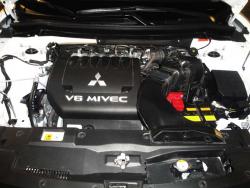 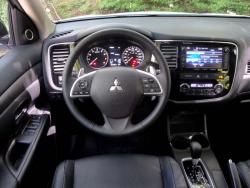 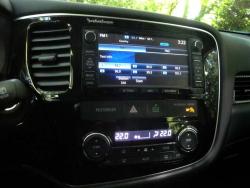 2014 Mitsubishi Outlander GT S-AWC Navi. Click image to enlarge |
Of course, if you’re willing to give up the V6 engine’s power and refinement, you can find better fuel economy in the Outlander’s base I4 and CVT combination, which has improved fuel economy by about 10 percent – 9.8 city/8.1 highway. We’ll be doing a full test drive of the four-cylinder Outlander at a later date.
While base ES 2WD Outlanders come with front-wheel drive, ES AWC and SE AWC models offer Mitsubishi’s All-Wheel Control system while GT S-AWC models feature Mitsubishi’s more sophisticated Super All-Wheel Control. Mitsu’s improved AWC system uses additional engine, transmission, steering, g-force and yaw rate sensors to determine the distribution of torque from front to rear wheels. Same goes for the S-AWC system, which also includes an active front differential that allocates torque from side to side in the front as well. As well for 2014, both AWC and S-AWC feature the new driver-selectable Eco mode for improved fuel economy.
In our GT S-AWC model, a button between the front seats allows the driver to choose between AWC Eco, Normal, Snow and Lock as displayed in a small screen in the instrument cluster. While driving, it’s difficult to tell any difference between AWC Eco and Normal driving modes, but the former is designed to run in front-wheel drive until some wheel slippage is sensed and then send some power to the rear wheels; while Normal mode spends more time in all-wheel drive. The Snow setting is designed to improve stability on snow-covered roads while Lock splits front-to-rear torque evenly to get out of snow banks or difficult conditions. S-AWC also includes an active front differential to distribute torque side to side and AYC brake control to improve traction and help stability when cornering and making sudden lane changes. A combination of ABS brake control and the active front differential helps steer the Outlander through a turn with more stability. All of this is basically invisible to the driver in everyday driving but it’s a good thing to have when the weather turns nasty. The Outlander even includes a graphic display in the instrument panel that shows the real-time power distribution between the axles.
    2014 Mitsubishi Outlander GT S-AWC Navi. Click image to enlarge |
The 2014 Outlander GT S-AWC also includes three new safety features that aren’t available in lesser models: Lane Departure Warning (LDW), Forward Collision Mitigation (FCM), and Adaptive Cruise Control (ACC). At speeds at or above 65 km/h, LDW uses a camera on the windshield to determine which lane you’re in, and issues an audible and visual warning if the Outlander begins to stray over the line. This works well but I found it annoying at times because it activates before you’ve crossed the line. It can be turned off via a button on the dash.
FCM uses radar sensors to judge the approaching speed to other vehicles in your lane and issues an audible and visible warning if a collision is imminent. If a collision is imminent, the Outlander will automatically brake; at speeds below 30 km/h, the Outlander can stop in time, but at speeds above 30 km/h, it can only help reduce the severity of the impact. The driver can activate two FCM settings: Near or Far modes. There’s really no need for FCM if drivers are looking where they are going, but it could be useful if a driver momentarily took their eyes off the road to tune the radio or adjust the heater at the same time a car stopped in its path. One caveat: FCM won’t sense pedestrians, cyclists or animals.
ACC uses the same radar sensors as FCM to maintain a safe following distance to the car ahead by slowing down and speeding up as appropriate. The driver can set three distance ranges: 2.3 seconds, 1.8 seconds, and 1.4 seconds.
I found the new Outlander to be a wonderful highway cruiser. New sound insulation, a more aerodynamic body, new engine mounts, and an improved body structure result in less mechanical and road noise in the cabin. The quiet V6 revs along at just 2,000 rpm at 100 km/h in sixth gear. As well, its fully independent suspension offers a compliant ride over bumpy roads and the steering is accurate without requiring much effort. I especially liked the Outlander’s tight 10.6 m (34.8 ft.) turning circle. Eighteen-inch tires and wheels are standard: my vehicle was equipped with Toyo A24 225/55R18-inch all-season tires on alloy wheels.
    2014 Mitsubishi Outlander GT S-AWC Navi. Click image to enlarge |
Perhaps the most important changes to the 2014 Outlander are in the passenger cabin: a redesigned instrument panel, upgraded interior materials, more interior features, and more advanced safety features top the list. The new interior design makes use of soft-touch plastics, turned steel-like trim on the doors and dash, piano-black dash trim, and subtle chrome borders. As well, though it’s not immediately obvious, there have been some significant improvements in ergonomics: the steering wheel now tilts and telescopes, the transmission shift lever has been moved further back in the centre console where it’s easier to reach, the centre stack is closer to the driver, and the touchscreen is larger. New dual-zone automatic climate control now includes a small display screen for fan speed, ventilation and temperature readings, while a new set of buttons controls fan speed and temperature. Personally, I prefer the old round dials to the buttons, though.
As before, the large metal paddle shifters behind the steering wheel don’t move with the steering wheel. Fortunately, you don’t have to use them very often. Interestingly, there isn’t an option of shifting manually with the shift lever.
I found the front leather seats in the GT very comfortable during the week that I had the Outlander, despite the lack of a driver’s lumbar adjustment. The seats include power height and recline functions and two-step seat heaters. The Outlander’s step-in height is not too high, the door openings are big and driver visibility is good except for a rear seat head restraint that can block the view depending on the position of the rear seat.
    2014 Mitsubishi Outlander GT S-AWC Navi. Click image to enlarge |
The Outlander’s second row seats have firmer cushions than the front seats but the backrests do recline and the split seats slide fore and aft to increase legroom. Rear legroom is good but headroom is not as roomy as I expected. Folding down the split folding rear seatbacks is a bit of a chore: first, you have to remove the head restraint, then lift up the seat cushion and flip it forwards against the front seatback; then store the head restraint in the gap near the seat cushion, then lift up the lever on the seatback top and fold down the seatback. This has to be repeated for the other side of the rear seat. This design has the advantage of creating a level cargo-loading surface, but it’s a lot of work!
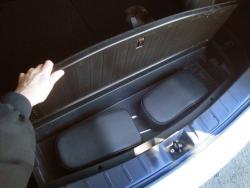 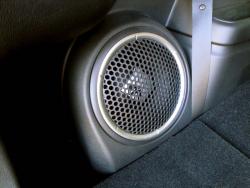 2014 Mitsubishi Outlander GT S-AWC Navi. Click image to enlarge |
A third-row seat is standard in Outlander V6 models, but it’s only for small people. Positioned between the two rear suspension housings, it’s narrow and has a low seating position and high floor. Still, there is occasionally a need for an additional two seats when parents are ferrying young children to school, sports events, or birthday parties. And when the seat is not in use, it can be folded flat to increase cargo room. You can store its two removable head restraints underneath the cargo floor when the seat is not in use.
A sliding privacy cover hides valuables in the cargo area, and it is removable when the rear seats are folded. In most Outlanders, it can be stored under the cargo floor, but in the GT S-AWC, the rear subwoofer for the optional Rockford Fosgate audio system gets in the way and prevents the privacy cover from fitting under the floor.
Our top-of-the-line Outlander GT S-AWC test vehicle had the new 6.1-inch centre touchscreen with navigation system and rear-view camera. This screen includes touch controls for audio, Sirius satellite radio, trip information and navigation. The navigation features new 3-D maps with prominent buildings displayed, and split screen capability as well as voice activation to find your destination, including general commands such as, ‘restaurants nearby’, ‘gas stations nearby.’ There’s also voice-controlled Help if you don’t know what you’re doing. A new feature of the 2014 navigation system is directional arrows shown in the instrument cluster between the gauges.
    2014 Mitsubishi Outlander GT S-AWC Navi. Click image to enlarge |
The Outlander’s trip computer provides average fuel consumption, distance to empty, average speed etc. but it also offers some unique info such as short- and long-term history of fuel consumption, an Eco score over a period of four days, current latitude and longitude, history of the outside temperature for the last three hours, the altitude, and even a barometer reading! So at least if you’re a budding meteorologist you’ll know if there’s a storm coming.
Note that though the centre screen displays climate control functions such as ventilation and temperature, those functions cannot be controlled using the touchscreen; to operate the climate control, you must use the regular buttons below the screen.
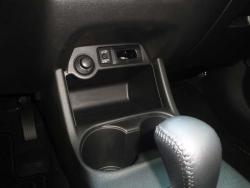 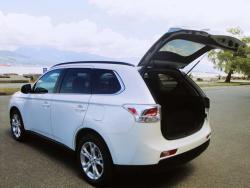 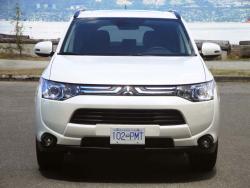 2014 Mitsubishi Outlander GT S-AWC Navi. Click image to enlarge |
Cabin storage space in the Outlander is sufficient: between the front seats is a storage bin with USB and 12-volt outlets inside, the glovebox has a slot for an iPad, there’s an open bin in the centre console, two front door pockets, map pockets on the back of the front seats, and some underfloor storage in the trunk, plus two cupholders in front, two in the second row, and two more in the third row.
One new design feature that may be a problem for current Outlander owners is the rear hatchback: the previous split rear hatch/flip-down tailgate design has been replaced by a one-piece lift-up hatch (power operated in the GT). The previous drop-down tailgate was handy for resting packages on and provided a small barrier over which you could throw packages into the cargo area. However, the new liftgate makes it easier to load bulky items and reach items deep in the cargo area. In this respect, Mitsubishi is following the current trend to single, lift-up hatch designs.
Reviews of the 2014 Outlander’s new styling have been mixed: this more generic, non-controversial shape has replaced the sharper lines of the previous Outlander, which bore similarities to the much-loved Lancer Evo. The belt line is higher and the fenders are rounder, and though it looks bigger, it’s actually 10 mm shorter in length. Admittedly, it’s not a particularly distinctive design but neither are many other vehicles in this class.
2014 Outlanders come in four basic trims: ES FWD ($25,998), ES AWC ($27,998), SE AWC ($30,998), and GT S-WC ($35,998). Our tester, the top-of-the-line 2014 Outlander GT S-AWC model with navigation ($38,728) came standard with just about every option available. With a Freight charge of $1,450, a pre-dealer inspection charge of $250, and A/C tax of $100, the as-tested price came to $40,528.
That may sound expensive, but it is on par with comparably equipped competitors like the Ford Escape Titanium 4WD, Subaru Forester XT Limited, Chevrolet Equinox LTZ AWD, and Kia Sportage SX. All these top-trim models go for over $40K with taxes.

























Lastly, mention should be made of Mitsubishi’s industry-leading warranty: 5 years/100,000 km basic; 10 years/160,000 km powertrain; 5 years/unlimited mileage roadside assistance. However, Mitsubishi has only 85 dealers in Canada.
|
Related Articles: Manufacturer’s Website: Photo Gallery: |
Pricing: 2014 Mitsubishi Outlander GT S-AWC Navi
Base price (ES): $25,998
Base price (GT S-AWC Navi): $38,728
Freight: $1,450
Pre-Dealer Inspection: $250
A/C tax: $100
Price as tested: $40,528
Competitors:
Chevrolet Equinox
Ford Escape
GMC Terrain
Hyundai Tucson, Santa Fe
Jeep Patriot
Kia Sportage
Mazda CX-5
Nissan Rogue
Subaru Forester
Toyota RAV4
VW Tiguan
Crash Test Results:
National Highway Traffic Safety Administration (NHTSA)
Insurance Institute for Highway Safety (IIHS)











